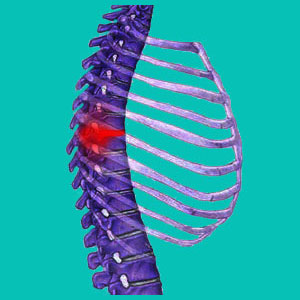
A thoracic bulging disc is the least often seen type of intervertebral protrusion, since the middle and upper back spinal regions are far less likely to develop herniated discs. However, when thoracic disc bulges do occur, they can be just as problematic as any other type of disc abnormalities, if not more so. The discs in the middle and upper back regions do not endure the same degree of movement and activity stress endured by the discs in the neck and lower back. This helps the thoracic discs to weather time and age better than the intervertebral spacers at the uppermost and lowermost ends of the spinal column.
When a thoracic intervertebral bulge is found, it may present some treatment difficulties for some care providers, since most interventions are geared towards targeting herniations in the cervical and lumbar spines. This is especially true when discussing surgical herniated disc treatment approaches.
This essay takes a focused look at thoracic bulging discs in the spine. We will examine their causation, their potential effects and the typical therapies used to resolve them.
Causes of Thoracic Bulging Discs
While most herniated discs are caused by age and activity, those in the thoracic spine defy this pattern. The upper and middle back regions are engineered for stability and are reinforced by the ribcage. The thoracic spine is not called upon to bend from one level to the next in the same manner as the lumbar and cervical spinal regions. This fact spares the thoracic region tremendous stress over the course of an average lifetime.
This lack of individual vertebral level movement also helps to preserve the integrity of the thoracic spinal discs. While the lumbar and cervical discs desiccate and deteriorate, it is common for the thoracic discs to stay youthful longer and resist the usual types of degeneration that befall the upper and lower spine. However, some thoracic disc bulges do occur and in these cases, one of the following scenarios is usually to blame for facilitating or directly causing the disc abnormality:
Spinal injury can occur anywhere and might affect the thoracic spine. Trauma is still a major source of herniated discs, regardless of where they occur in the spinal anatomy. However, since the thoracic spine is safeguarded by the ribcage to a large degree, even injury is less prevalent as a source of herniated discs in the middle and upper back areas.
Thoracic spinal irregularities, such as scoliosis or hyperkyphosis, often facilitate intervertebral bulging in surrounding levels.
Idiopathic bulges also occur in the thoracic spine, with some discs bulging, or rupturing for no apparent reason.
Thoracic Disc Bulge Consequences
Like most other intervertebral bulges, thoracic herniations are usually not symptomatic and if they are, the expressions will usually resolve without any special treatment. The only ways for intact thoracic bulges to create pain are through the processes of central spinal stenosis or neuroforaminal stenosis. If neither of these consequences occur, then the disc is unlikely to have anything at all to do with an existing pain complaint.
If the thoracic bulging disc pressures a nerve root within the central canal, within the lateral recess, within the neuroforamen or after the nerve has already left the foramen, then pinched nerve symptoms might result. These symptoms should follow a logical progression if compression continues, but many pinched nerve diagnoses will improve organically with time, rather than worsening.
If the thoracic disc bulge places pressure against the spinal cord, then central stenosis might result and might create wide-ranging and potentially very serious symptoms.
If other symptoms exist that do not stem from one of these two processes, the diagnostician should check to be sure that the disc is truly intact and not leaking potentially irritating proteins. If it is, then chemical radiculitis might be a valid diagnosis for a few patients who do not demonstrate actual structural nerve compression, but still suffer pain in the local region of the herniation.
Thoracic Bulging Disc Interventions
Conservative and moderate types of treatments for truly pathological bulges in the thoracic spine mirror those interventions used for lumbar or cervical herniated discs. The traditional medical approach will usually begin with drug therapy, physical therapy and might then progress to injection therapies if the pain persists.
Meanwhile, complementary caregivers will treat herniations differently and might use a variety of care techniques depending on the nature of their healing background. Some of the more popular complementary bulging disc treatments include chiropractic, massage and acupuncture. Moderate treatment in complementary care is usually only provided by chiropractors and usually consists of nonsurgical spinal decompression. While this treatment is also available from some traditional physicians, it is the caregivers who do not provide or endorse surgery who have adopted it the most. Nonsurgical decompression therapy is unique in that it can truly cure pathological bulges without surgery, using a safe and modernized form of focal spinal traction.
Regardless of the type of care provided to most patients, if their pain is unresponsive, they will almost certainly receive a recommendation to see a surgeon for a consultation at some point during the treatment process. Bulging disc surgery generally focuses on the neck and lower back as its intended target locations. These procedures can still be applied to the thoracic spine, but some doctors are limited in their experience treating mid and upper back disc bulges, while some techniques will not work at all due to the anterior approaches not being available for every spinal level. Finding a surgeon who is experienced with thoracic disc abnormalities will improve the likelihood for a positive postoperative outcome considerably.
Thoracic Bulging Disc Summary
Thoracic bulging discs usually occur at or near the frontier regions of the spine. Many occur at the cervicothoracic juncture of C7/T1, while others occur at the thoracolumbar juncture of T12/L1. A few bulges will occur close to these crucial levels, such as T1/T2, T2/T3 or T11/T12. As one moves inward towards the center of the thoracic spine, herniations become the least common of all.
Regardless of where a thoracic disc bulge might occur, the main point to remember is that most herniations are not pathological. They do not require any specialized care and virtually never actually require surgery. This statement is not a rule that is set in stone, but is certainly supported by the majority of incidental bulges found in asymptomatic patients. Therefore, as always, we recommend getting several professional opinions before seeking care for any disc bulge that is blamed as the cause of pain, especially without definitive evidence of a stenotic process occurring.





